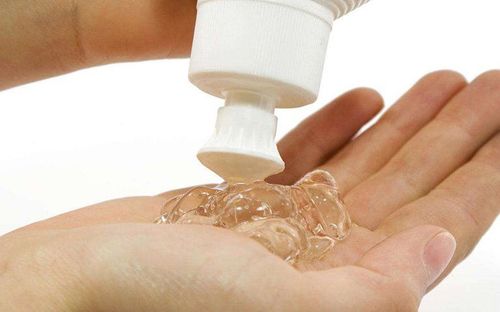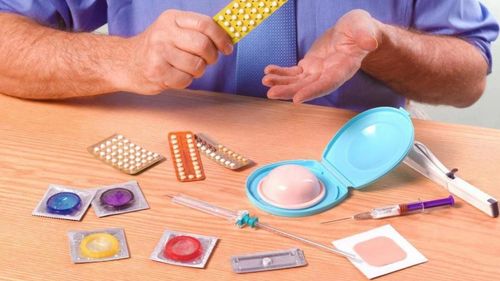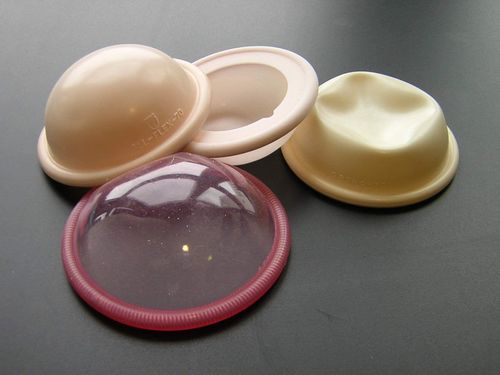This is an automatically translated article.
Diaphragm is a contraceptive device that prevents sperm from entering the uterus. This remedy is only effective when used in conjunction with a spermicide. This article will provide information on the pros and cons of diaphragms.
1.What is the diaphragm? The diaphragm is a shallow dome-shaped device made of rubber or silicone that is partially filled with spermicidal cream or jelly and inserted into the vagina before sex. The diaphragm is a barrier method of contraception. Physically, it blocks sperm from entering the cervix and keeps the spermicide near the cervix to destroy any sperm that might have gotten around the rim of the ear.
2. How can I trust the diaphragm to work? When used consistently and correctly, the diaphragm is approximately 94% effective. This means that about 6 out of 100 women who use it correctly will become pregnant within the first year of use.
Generally, about 12% of women who rely on a diaphragm for contraception end up getting pregnant within the first year they use it. This includes women who don't use a diaphragm every time they have sex as well as those who insert it incorrectly or don't use spermicide.
Because the diaphragm has a relatively high failure rate even when used correctly, you may want to use an additional method, such as a condom, or consider using a reliable method of contraception. more reliable.
If you only rely on the diaphragm to prevent pregnancy, you should have emergency contraception on hand. So you'll be prepared if the diaphragm slips out of place or forgets to use it. The sooner you take these pills after unprotected sex, the more likely they are to work.
3. Can I use a diaphragm if I'm breastfeeding? The diaphragm is a good choice for women who are breastfeeding because it is not hormone dependent and does not have any effect on breast milk production, unlike the combination pill. If you are exclusively breastfeeding and meet all other criteria for the lactating amenorrhea method (LAM), the addition of a diaphragm provides you with a high degree of pregnancy protection.

Màng ngăn là lựa chọn tốt cho phụ nữ đang cho con bú
4. Will the diaphragm protect me from sexually transmitted infections? No. If you are at risk for an STI, you should use latex condoms, or if they are not a good choice for you, use a male or female polyurethane condom. Furthermore, if you are at high risk of infection, you should not use spermicide, as regular use can irritate your genitals making you more susceptible to HIV and other sexually transmitted diseases. other sexual routes if you are exposed.
5. How can I use a diaphragm? You will have to be provided by medical personnel. The medical staff will do a pelvic exam to estimate the size of your diaphragm. She'll then insert diaphragms (or fit rings) of various sizes to find the best fit for your body.
After determining the correct size and type, they will teach you how to use the diaphragm, let you practice installing it yourself and check that you have done it correctly. The medical staff will then give you a prescription for your own diaphragm.
6. How long can I use the diaphragm after giving birth? Your healthcare provider may try to insert a diaphragm on you at your six-week postpartum visit, although you may have to wait a little longer if she determines that your vagina has not regained enough muscle tone to heal. have a fit body.
Even if you have used a diaphragm before, you will need to try again as you may need a different size after delivery. In the meantime, use another method, such as a condom.
7. How do I use the diaphragm? Some general guidelines for the use of the diaphragm are given below, but it is recommended that you refer to the accompanying written and illustrated instructions.
7.1. Preparing to use your diaphragm When you first bring your diaphragm home and before using it during sex, try it on and wear it for six hours or so. You want to make sure the diaphragm stays comfortable even after hours. Otherwise, you need to return to the medical facility to check the fit before using it to prevent pregnancy.
Before you use the diaphragm, make sure it is in good condition. Do not use it if it is more than two years old or feels brittle or has any cracks, tears or holes. Keeping the diaphragm or filling it up with water is a good way to check for holes.
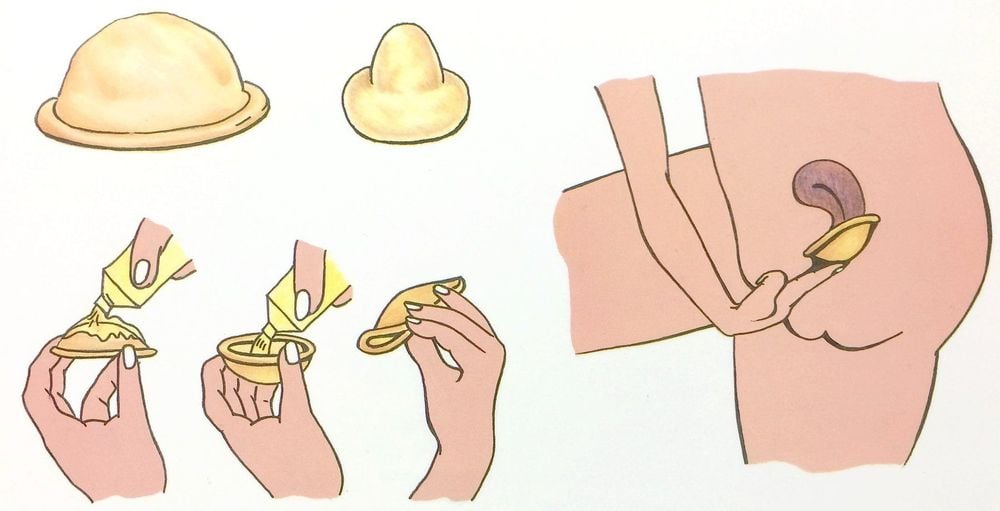
Cách sử dụng màng ngăn tránh thai
It is important to use a backup method, such as a condom the first few times you use the diaphragm, in case you have an unexpected problem and it comes off during sex.
7.2. Inserting a diaphragm You can insert your diaphragm two hours before having sex. When you're ready, pee. Then, squeeze about a tablespoon of jelly or spermicide cream into the dome of the diaphragm and dab a little around the rim. Always remember to use spermicide with a diaphragm.
To make insertion easier, you can squat, lie down with your knees raised, or stand with one foot on a chair. Hold the diaphragm by the rim and press the opposite sides together. Then, widen the labia and push the diaphragm in with the dome down.
Slide the diaphragm along the lower wall of the vagina as far as possible, so that the foreskin is inserted deep into the vagina behind and below the cervix, then pull the anterior rim just behind the pubic bone.
Once the diaphragm is in, check to make sure that the dome covers your cervix. Insert a finger into the vagina and feel the cervix through the dome of the diaphragm, the cervix should feel a bit like the tip of a nose.
If the cervix is not covered or the diaphragm feels uncomfortable, remove it, add spermicide and try again. If you're not sure if you've placed it correctly or feel uncomfortable, schedule an appointment with your doctor or health professional and use another method of birth control in the meantime.
If you want to use lubricant during intercourse, you can use a water-based lubricant. Never use an oil-based lubricant, such as kerosene, baby oil, mineral oil, body cream, cold cream or vegetable oil, with a latex rubber diaphragm as it will rot the rubber. If you have a silicone diaphragm, you can use any type of lubricant you want.
7.3 After sex After intercourse, check to make sure the diaphragm is not dislodged. You must leave it alone for at least six hours after the last sex so that the spermicide has a chance to kill all the sperm. And don't douche for at least six hours after you last had sex.
The diaphragm can be left on for up to 24 hours after you first use it, but it is best to remove it six to eight hours after intercourse. The longer it is left, the higher the risk of the rare disorder toxic shock syndrome, which is taken very seriously.
If you want to have sex again before six hours have passed, check that your diaphragm is still in place and then insert more spermicide into the vagina with the applicator without removing the diaphragm compartment. Some experts recommend doing this with every repeated intercourse, even if it happens immediately. Or you can ask your partner to use a condom instead of adding spermicide because using spermicide more than once a day can irritate the vagina. If your partner uses a condom, you still need to keep the diaphragm in place for six hours after the last time you had sex.
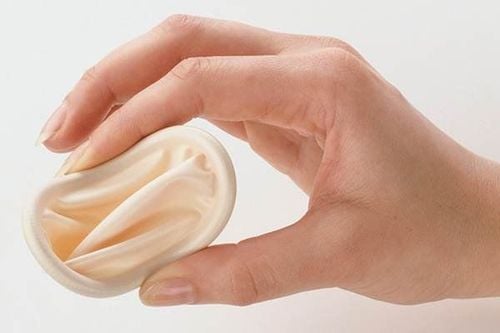
Phụ nữ nên lấy màng ngăn ra sau 6-8 giờ sau khi quan hệ tình dục
7.4. Removing the diaphragm To remove the diaphragm, wash your hands with soap and water, insert your index finger into the vagina, put your hand behind the pubic bone, hook your finger behind the anterior rim, and pull it down. Be careful not to puncture the rubber with your nails.
If you have difficulty removing the diaphragm, try to exert pressure with your pelvic muscles as you try to pull the diaphragm out or put your finger between the rim and vaginal wall to break the suction before touching top rim to pull it out.
7.5. Caring for Your Diaphragm After each use, wash the diaphragm with plain, unscented soap and water and recheck it for punctures or tears. Dry completely with a clean cloth and return it to its container. (You can cover it with some cornstarch to keep moisture out if you want, but never use baby powder or any other powder on top.)
8. What should I do if I find out that my diaphragm is deviated during sex? If your partner has ejaculated inside your vagina and then you find out that your diaphragm has come off during intercourse, you have a high risk of pregnancy.
If this is the case, add royal jelly or spermicide immediately. Although you can't count on this to be able to prevent pregnancy, it's probably worth a try. (Don't douche, as it won't help prevent pregnancy or infection and can make matters worse.)
The only way to significantly reduce your risk of getting pregnant is to use emergency contraception and use it. The earlier it is, the more likely it is to work.
9. How do I know when I need a new diaphragm? You will need to replace the diaphragm at least every two years, or sooner if it shows any signs of damage. Make sure to check for holes, tears, and cracks each time you use it. Bring your diaphragm with you to your annual check-up so your doctor can check the fit.
You should also ask your healthcare provider to check the fit of your diaphragm after you undergo pelvic surgery, lose or gain 20% or more of your body weight, have an abortion or miscarriage, or give birth. These can change the size and shape of your cervix and vagina enough to create a needed new diaphragm.
10. Can I use a diaphragm while I have my period? No. Diaphragms should not be used during your period (or any other time when you have vaginal bleeding) because the risk of toxic shock syndrome is higher during menstruation.

Khi xuất hiện kinh nguyệt, phụ nữ không nên dùng màng ngăn âm đạo
11. Can I use a diaphragm while taking a vaginal suppository? You can use a silicone diaphragm but do not use a rubber membrane. Vaginal creams and suppositories that treat yeast infections, as well as estrogen creams and suppositories, often contain oil-based ingredients that can damage latex and other rubbers. Use another method such as a polyurethane condom or do not have sex while using these drugs.
12. Does the diaphragm cause any side effects or health effects? Using a diaphragm can make you more susceptible to urinary tract infections (UTIs), yeast infections, and bacterial vaginosis.
To help protect against these infections, keep your diaphragm less than necessary to protect your pregnancy, you need to leave it on for at least six hours after having sex. Urinating immediately after intercourse can help prevent UTIs. Tell your healthcare provider if you think you have a UTI so you can get tested and treated.
If you get recurrent UTIs while using the diaphragm, they may be related to the pressure the diaphragm puts on the urethra or the spermicide, which can change the acidity and balance of bacteria. bacteria in the vagina and create conditions for bad bacteria to multiply.
The medical staff will recheck the fit and prescribe a different type or size of rim if appropriate. If that doesn't solve the problem, you'll need to switch to a birth control method that doesn't require spermicide.
If you are experiencing vaginal irritation but the test shows no sign of an infection, it could be due to an allergy or sensitivity to latex or spermicide.
If it's rubber, you can try switching to a silicone diaphragm. If spermicide is the culprit, you can try another brand. If that doesn't work, you'll need to find another birth control method. You also need to change if your partner is allergic or sensitive to latex or spermicide.
Diaphragm use has been linked to an increased risk of toxic shock syndrome, a rare but serious illness caused by common bacteria releasing toxins into the bloodstream. To reduce your risk, make sure to follow the instructions carefully, remove the diaphragm 6 to 8 hours after sex, and never leave it on for more than 24 hours after you first put it on.
Signs of toxic shock include: sudden high fever, vomiting, diarrhea, dizziness, weakness, sore throat, soreness, red eyes and rash like sunburn. Call your doctor at once if you have a high fever and any of these other symptoms.
13. Who shouldn't use a diaphragm? You will not be able to use the diaphragm if:
You are uncomfortable touching it yourself or have trouble fitting the diaphragm properly. You or your partner are allergic or sensitive to spermicide. You have had toxic shock syndrome. Your cervix, vagina, or uterus has an irregular shape that doesn't allow for a snug fit, or the vagina is so loose that the diaphragm won't stay in place. You get recurrent UTIs while using a diaphragm and the problem persists even after trying a new size or type of diaphragm. You are at high risk for HIV or other sexually transmitted diseases. (The diaphragm won't protect you, and regular use of spermicide can make you more susceptible to STIs if exposed.)

Hãy đến gặp bác sĩ chuyên khoa Sản phụ khoa nếu bạn cần hỗ trợ và tư vấn về cách phòng tránh thai an toàn
Currently, there are many methods of contraception that you can trust and have high safety such as IUD, daily use of birth control pills, use of condoms. The diaphragm also has certain advantages and disadvantages. So you can consider and choose the right contraceptive method.
Vinmec International General Hospital is the address for examination, treatment and prevention of many diseases, including the specialty of Obstetrics and Gynecology. Therefore, if you are looking for a place to visit and want to have a suitable method of contraception, you can go to Vinmec for the best advice from experienced and qualified doctors. With the dedication and enthusiasm of the medical team, along with modern facilities will definitely make you satisfied.
Please dial HOTLINE for more information or register for an appointment HERE. Download MyVinmec app to make appointments faster and to manage your bookings easily.
Reference source: babycenter






